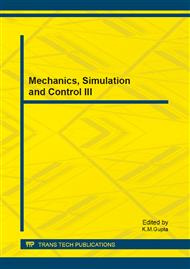[1]
M.C. Huang, Wave Parameters and Functions in Wavelet Analysis, Ocean Engineering, Vol. 31, No. 1, 2004, pp.111-125.
Google Scholar
[2]
Darnin E D. A Simple Procedure for Pruning Back-Propagation Trained Neural Networks, IEEE Trans. Neural Networks. 1990, 1(2). pp.239-242.
DOI: 10.1109/72.80236
Google Scholar
[3]
NOH Min-Seok, HONG Dae Sun, Implementation of remote monitoring system for prediction of tool wear and failure using ART2, Journal of Central South University of Technology (English Edition). 2011, 18(1). pp: 177-183.
DOI: 10.1007/s11771-011-0677-7
Google Scholar
[4]
F. F. Alonso and D. R. Salgado, analysis of the structure of vibration signals for tool wear detection, Mechanical Systems and Signal Processing, Vol. 22, No. 3, 2008, pp.259-267.
DOI: 10.1016/j.ymssp.2007.09.012
Google Scholar
[5]
R.J. Williams and D. Zipser,: A learning Algorithm for Cont- inually Running Fully Recurrent Neural Networks,: Neural Computation, Vol. 1, 1989, pp.270-280.
DOI: 10.1162/neco.1989.1.2.270
Google Scholar
[6]
Wang Wu, Su Liang-yu. Application of CMAC-PID Compound Control in PMLSM Servo System[J]. Advanced Materials Research Vols. 341-342(2012), pp.780-784.
DOI: 10.4028/www.scientific.net/amr.341-342.780
Google Scholar
[7]
Wang Wu, Wang Hong-ling, Bai Zheng-min. Fault Diagnosis of Three Level Inverter Based on Improved Neural Networks[J]. Lecture Notes in Electrical Engineering, 2011, Vol. 97, pp.55-62.
DOI: 10.1007/978-3-642-21697-8_8
Google Scholar
[8]
WU Yanliang, Ju Jiangang, Sun Youxian. An improved differential evolution for optimization of chemical process, CHINESE JOURNAL OF CHEMICAL ENGINEERING, 2008, (16)2, pp.228-234.
DOI: 10.1016/s1004-9541(08)60068-3
Google Scholar
[9]
YE XU, LING WANG. Differential evolution algorithm for hybrid flow-shop scheduling problems, JOURNAL OF SYSTEMS ENGINEERING AND ELECTRONICS. 22(5). pp.794-798.
DOI: 10.3969/j.issn.1004-4132.2011.05.011
Google Scholar
[10]
Y. Xu, L. Wang, L. P. Li. An effective hybrid algorithm based on simplex search and differential evolution for global optimization. Lecture Notes in Artificial Intelligence, 2009, 5755, pp.341-350.
DOI: 10.1007/978-3-642-04020-7_36
Google Scholar
[11]
WANG WU. Adaptive neuro sliding mode control for inverted pendulum. 2010 2nd Internation Conference on Computer Engineering and Technology (ICCET2010), 2010, VOL 1, pp.135-138.
DOI: 10.1109/iccet.2010.5486253
Google Scholar
[12]
Wang Wu, Wang Hong-ling, Bai Zheng-min. Fault Diagnosis of Three Level Inverter Based on Improved Neural Networks[J]. Lecture Notes in Electrical Engineering, 2011, Vol. 97, pp.55-62.
DOI: 10.1007/978-3-642-21697-8_8
Google Scholar


